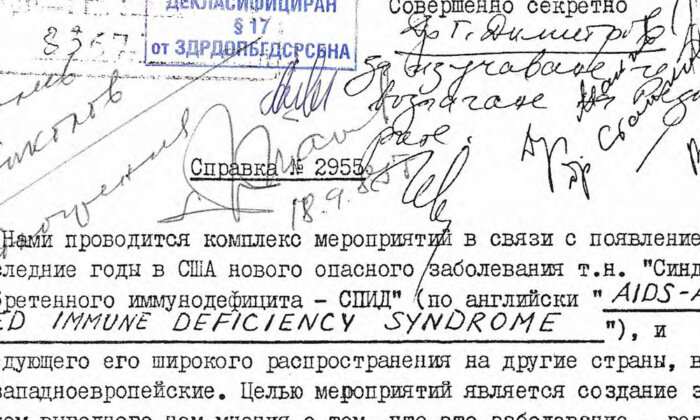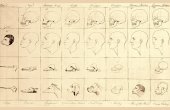Lessons From Operation “Denver,” the KGB’s Massive AIDS Disinformation Campaign

In September 1985, the Soviet State Security Committee (KGB) informed other Warsaw Pact foreign intelligence agencies that it had launched a new, major disinformation campaign. “We are carrying out a complex of [active] measures in connection with the appearance in recent years of a new dangerous disease in the USA known as AIDS (Acquired Immunodeficiency Syndrome).” The KGB explained that “the goal of the measures is to create a favorable opinion for us abroad — namely, that this disease is the result of secret experiments by the USA’s secret services and the Pentagon with new types of biological weapons that have spun out of control.” Most likely, the KGB had initiated the disinformation campaign as early as 1983, but the September 1985 document — obtained by Christopher Nehring from the former Bulgarian State Security archive — is the earliest conclusive evidence that has turned up so far. (The former KGB foreign intelligence archive has never been accessible to researchers.)

Among the East European intelligence services that assisted the KGB in this effort was the East German Ministry for State Security (Stasi), which used the codename “Denver” when referring to the campaign. The KGB and Stasi relied on forged documents and inaccurate testimony from purported experts to suggest that HIV, the virus that causes AIDS, had originated not from infected animals in Africa but from biological warfare research carried out by U.S. military scientists at Fort Detrick in Maryland. Operation Denver proved remarkably effective, writes historian Douglas Selvage in an article featured in a recent issue of the Journal of Cold War Studies; indeed, even more effective than the KGB and Stasi had originally expected. Before long, immense numbers of people around the world (including in the United States) came to believe, falsely, that the U.S. government was responsible for AIDS.
Selvage’s article appeared a few months before Covid-19 burst into public consciousness. The Covid-19 pandemic has provoked a wide range of lurid conspiracy theories in countries whose governments are hostile to the United States, notably Russia, China, Iran, and Venezuela. The conspiracy theories circulating in 2020 are more diffuse and less coherent than the disinformation propagated by the KGB and the Stasi in the 1980s, but the two periods bear distinct similarities. In both cases, authoritarian regimes have exploited widespread public fear and confusion to generate suspicions about U.S. motives, to stoke hostility toward the United States, and to discredit the U.S. government’s sincerity in combatting the global pandemic.
In our exchange featured below, Selvage sheds light on the origins and main purpose of operation “Denver” and considers the lessons we may learn in responding to Russian and Chinese disinformation in 2020.
Mark Kramer: The Soviet KGB was the agency that originated the AIDS disinformation campaign, but the KGB enlisted the East German Stasi early on to help out. To what extent did other Soviet-bloc intelligence agencies also participate? Did the Stasi play the lead role after the Soviet KGB?
Douglas Selvage: Based on statements by KGB and Stasi officers to their Bulgarian counterparts in 1986-9, the Stasi’s foreign intelligence branch (Hauptverwaltung Aufklärung, HVA) played a central role in the disinformation campaign alongside the KGB. Bulgarian and especially Czechoslovak foreign intelligence also assisted, but mainly in terms of spreading leaflets around U.S. military bases and encouraging stories in the local press in NATO countries. These claimed (falsely) that U.S. service members suffered a high infection rate with HIV and were spreading AIDS locally around U.S. military bases. The Cuban government also played a role in spreading AIDS disinformation about the U.S. in Latin America, but the details remain unclear.
M.K.: Why did the Stasi give the codename “Denver” to the disinformation campaign?
D.S.: We actually do not know why the Stasi chose this particular codename because the HVA destroyed around 90 percent of its records in 1989-90, including the files for Operation Denver. One can only speculate. It is possible that a Stasi officer heard the term “Fort Detrick” and thought “Denver” instead of “Detrick” – that is, a geographical term more familiar to most Germans. At the time, a popular program on West German television, also viewed in East Germany, was “Denver-Clan,” the German name for the popular U.S. television series “Dynasty.” But this is all just speculation. As early as 1987, the Stasi officers responsible for the AIDS disinformation campaign began using the terms “Denver” and “Detrick” interchangeably in talks with their Bulgarian counterparts. The use of “Denver” had apparently created some confusion.
One term that never came up in talks between the Stasi and their Bulgarian counterparts, let alone in talks between the KGB and the Bulgarians, was “Operation Infektion.” Despite this fact, practically the entire internet continues to use this incorrect codename in discussing the KGB’s AIDS disinformation campaign. The New York Times even decided to use it as the title for its series of popular videos about Soviet and Russian disinformation.
M.K.: What was the main purpose of Operation “Denver”? What were the main types of disinformation activities?
D.S.: The KGB informed its Bulgarian colleagues in September 1985 that it had initiated a campaign of “active measures” — that is, covert propaganda — regarding HIV/AIDS. “The goal of these measures,” the KGB wrote, “is to create a favorable opinion for us abroad that this disease is the result of secret experiments with a new type of biological weapon by the secret services of the USA and the Pentagon that spun out of control.” Around a year later, the Stasi wrote to the Bulgarians about Operation “Denver,” its contribution to the KGB’s AIDS disinformation campaign. Through the operation, the Stasi sought to expose “the dangers to mankind arising from the research, production, and use of biological weapons,” “to strengthen anti-American sentiments in the world,” and “to spark domestic political controversies in the USA.” To this end, the Stasi promised to provide their Bulgarian “comrades” with “a scientific study and other materials that prove that AIDS originated in the USA, not in Africa, and that AIDS is a product of the USA’s bioweapons research.”
The “scientific study” to which the Stasi referred was clearly “AIDS: Its Nature and Origin” by the retired Soviet-East German biologist Jakob Segal and his wife, Lilli, a scientist and author in her own right. The Stasi claimed to have played a role in photocopying and distributing the study in a brochure entitled, “AIDS: USA home-made evil, NOT out of AFRICA” at a summit meeting of the Non-Aligned Movement in Harare, Zimbabwe in August-September 1986. This was a gathering of world leaders, mainly from the less-developed countries, that had proclaimed their neutrality in the superpower rivalry during the Cold War. Journalists, especially from Africa, reported on the Segals’ findings. The Segals were claiming — just like the KGB, but on the basis of a more “scientific” analysis — that HIV had leaked out of a U.S. military biological-weapons research lab at Fort Detrick, Maryland. The U.S. military, the Segals claimed, had used the very new technology of genetic engineering to construct HIV from two other dangerous viruses, including one that infected sheep.

Many leaders, journalists, and intellectuals in Africa welcomed the Segals’ thesis of a U.S. origin of HIV as an alternative to the hypothesis of many leading U.S. and Western scientists at the time. The latter were arguing — correctly, as it later turned out — that HIV had originated in Africa, where it had spread from non-human primates to human beings. Many Africans interpreted this hypothesis, especially given the scant evidence at the time, as an attempt to “blame” Africa and Africans for HIV/AIDS. In the weeks following the Harare summit, the Segals’ Fort-Detrick-thesis of AIDS’ origins spread throughout the press in Africa, India, and the world.
The Stasi apparently helped behind the scenes in bringing the Segals together with certain foreign journalists who were known quantities to its disinformation division. The official Soviet press agency Novosti also helped to spread the thesis abroad, alongside the KGB. The KGB happily noted that foreign journalists, without any prompting on its part, were also picking up on the claims and reporting them. For example, officials from the Reagan Administration were perturbed that Dan Rather reported the Soviets’ accusations about AIDS and Fort Detrick on the CBS Evening News in 1987 without requesting a U.S. government response.
The Stasi apparently helped behind the scenes in bringing the Segals together with certain foreign journalists who were known quantities to its disinformation division.
The Stasi also claimed to have covertly co-financed a documentary film shown three times on public-financed West German television in 1989 and subsequently in an English version on British Channel Four in 1990. The film featured an interview with the Segals, who expounded upon their thesis; conversations with journalists and African scientists, who denounced the hypothesis of a natural origin of AIDS in Africa as racist; and U.S. and Western critics of the ostensibly defensive U.S. biological-weapons research program. (No mention was made of the Soviet Union’s much larger, offensive biological-weapons research program, but little was publicly known about it at the time.)
The two co-creators of the West German film strenuously deny that the Stasi covertly financed the film or was involved with it in any other way. They also deny that they ever had any contacts to the Stasi. Whatever the case may be, officers from the Stasi’s disinformation division, ostensibly convinced that the film contributed to their goals for Operation “Denver,” encouraged Bulgarian and apparently also Czechoslovak foreign intelligence to covertly support the sale and distribution of the film’s German and English versions in non-communist countries.
The German film — or perhaps a bootleg version — can still be viewed on YouTube today.
M.K.: When you began writing about the Soviet-East German AIDS disinformation campaign, did you ever imagine that you might live through a global pandemic that would give rise to lurid conspiracy theories in Russia, China, and Iran claiming that the deadly pathogen was manufactured in U.S. biological defense laboratories?
D.S.: Strangely, in retrospect, I did not imagine living through another global pandemic in my lifetime, despite the warnings of the Obama Administration and the example of the HIV/AIDS pandemic. Many more of us should have known better.
Still, as a historian, I am not surprised that conspiracy theories would arise in response to the Covid-19 pandemic. Since the Middle Ages, if not long before, people have responded to epidemics and pandemics by trying to find a responsible party or parties, often in the form of a scapegoat. For example, some Christians in Europe blamed the Jews for the bubonic plague and responded with violence and murder.
Often, victims of repression and real conspiracies also respond with suspicion to pandemics and other disasters, and to explain the seemingly inexplicable, they craft conspiracy theories. For example, the KGB was not the first to accuse the U.S. government of constructing the AIDS virus. Already in 1983, some members of the gay community in the U.S. had accused the federal government of constructing the virus in order to kill off gay Americans. This came at least partly in response to their frustration with decades of discrimination, the accelerating death toll from HIV/AIDS, and the lagging, at times callous, response of the Reagan Administration to the pandemic. As it became clear that African-Americans were also suffering disproportionately from the disease, some African-Americans came to believe in and spread similar conspiracy theories. Such accusations seemed plausible to many, given the history of racism in the United States, including in the medical field. One particularly reprehensible episode was the Tuskegee syphilis study, in which the U.S. Public Health Service had observed the long-term effects of syphilis on infected African-American sharecroppers and their offspring for four decades, from 1932 to 1972, without providing them with effective medical treatment, even after penicillin had proven effective against the disease.
Of course, political extremists, in and out of power, often develop or exploit conspiracy theories to their own ends. In my article for the Journal of Cold War Studies, I demonstrate how the perennial right-wing U.S. Presidential candidate Lyndon LaRouche and his organization promoted a variant of the AIDS-from-Fort-Detrick thesis. They promoted the claim that a Soviet fifth column had infiltrated the National Institutes of Health through the World Health Organization and then genetically engineered the AIDS virus at the National Cancer Institute’s facilities at Fort Detrick. Although LaRouche’s organization counter-attacked the KGB disinformation with its own version of the Fort Detrick thesis, and the KGB and Moscow attacked LaRouche, both apparently borrowed elements from each other’s conspiracy theory in constructing their own.
A cycle of misinformation and disinformation arose in which the KGB cited U.S. conspiracy theories, and U.S. conspiracy theorists, in turn, began to cite texts associated with KGB disinformation.
In the case of the AIDS disinformation campaign, the KGB simply picked up on existing conspiracy theories in the U.S, added a new element that conformed to its disinformation goals (i.e., the exact location of HIV’s construction, Fort Detrick), and spread the resulting conspiracy theory internationally to its own ends. A cycle of misinformation and disinformation arose in which the KGB cited U.S. conspiracy theories, and U.S. conspiracy theorists, in turn, began to cite texts associated with KGB disinformation.
One can see a similar dynamic today between Russian disinformation and U.S. conspiracy theorists if one closely views Sputnik News and RT (formerly Russia Today) on Twitter and Facebook. Already during the Ebola epidemic in West Africa in 2013-16, these Russian propaganda outlets spread reports that the virus had been created by the U.S. in collaboration with Great Britain and South Africa in order to kill off Africans. That is, different virus, similar disinformation. So, it did not surprise me that certain propagandists in Russia spread similar rumors about the origin of Covid-19. Since I knew less about Chinese disinformation efforts, it surprised me that Beijing apparently decided to revamp the old, Soviet disinformation and to apply it to the new virus.
M.K.: What are the lessons we can learn from Operation “Denver” in responding to the Russian and Chinese disinformation now?
D.S.: During the Cold War, the Reagan Administration had an Active Measures Working Group that exposed and publicized examples of Soviet disinformation. It was particularly active in combatting the Soviet bloc’s AIDS disinformation. Over the long term, the ongoing exposure of Soviet disinformation efforts sparked a backlash internationally, helped discredit Soviet propaganda agencies and created effective pressure on the Soviet Union to curtail or at least to limit its activities. A similar, intensive effort by the U.S. and other democracies could also prove effective today. NATO allies such as Estonia have adopted such measures, but the U.S. is lagging behind.
From my perspective, it would be even more important, especially for the long term, to train students as early as elementary school to differentiate between facts and opinions and to identify not only propaganda techniques, but also fallacies in logic. There were some initiatives in this regard during the Cold War in the United States. I don’t know if they still continue today. Students and others would also benefit from training in internet literacy: What sources can one trust, and how can one fact-check various claims, especially before reposting them?
Students and others would also benefit from training in internet literacy: What sources can one trust, and how can one fact-check various claims, especially before reposting them?
There is one thing that democratic governments should definitely avoid in responding to disinformation — namely, spreading conspiracy theories and disinformation themselves. Of course, during the Cold War, the U.S. and other democracies did this, if not to the same extent as the Soviet Union and its allies.
Today, it absolutely does not help, for example, when the Trump Administration and other U.S. politicians openly promote their own conspiracy theories about Covid-19, including basically unsubstantiated claims that the virus escaped from a Chinese laboratory in Wuhan. This leads to fruitless public discussion along the lines of: “Who was responsible for constructing the virus — China or the U.S.?” Such apparently baseless accusations also make the public, especially in third countries, less willing to listen to other, substantiated criticisms of China’s response to the pandemic, including its initial suppression of warnings from doctors in Wuhan. The Chinese government has succeeded to some extent in lumping together accusations about the Wuhan laboratory with all other criticisms of its role and response to the pandemic as mere “China-bashing.”
The promotion of conspiracy theories regarding a virus’s origins can also undermine public health efforts to mitigate its spread and save lives. Studies show that individuals who believe in conspiracy theories regarding the origins of HIV/AIDS are less likely to follow medical advice regarding safe sex, to test themselves for potential infection, or to take effective medications to contain the disease. Such behaviors, of course, can lead to death. Apparently, believers in HIV/AIDS conspiracy theories reason as follows: If scientists and medical doctors cannot be trusted to tell the truth — or have been “duped” themselves — about a virus’s origins, why should one trust their medical or public health advice? Not surprisingly, there are also individuals who have turned a profit by selling publications with their own versions of the HIV/AIDS conspiracy theory alongside their own unproven, alternative therapies for the disease. In the case of HIV/AIDS, such quack therapies have included aspirin, alfa-interferon, the ultraviolet irradiation of blood, vitamin cocktails, traditional Chinese or African herbs, and colloidal silver. With regard to Covid-19 today, we see the spread of similar conspiratorial beliefs, an associated rejection of public health measures, and a similar propagation of unproven and potentially dangerous alternative therapies.
The example of the response to the HIV/AIDS pandemic by the democratically-elected government of South Africa under President Thabo Mbeki (1999-2008) should serve as a warning to us today as we grapple with Covid-19. He and his health minister came to believe in various conspiracy theories regarding HIV/AIDS from the internet, including the Fort Detrick thesis. They thus rejected the mainstream medical science on HIV/AIDS and came to promote various unproven alternative therapies — some mentioned above — for treating the disease. It has been estimated that the ensuing delay in the introduction of effective antiretroviral treatment for HIV/AIDS in South Africa contributed to up to 300,000 additional deaths from the disease.
Mark Kramer is director of Cold War Studies at Harvard University’s Davis Center for Russian and Eurasian Studies, and the editor of the Journal of Cold War Studies.
Douglas Selvage is a Research Associate (wissenschaftlicher Mitarbeiter) at the Institute for History of the Humboldt University in Berlin.



